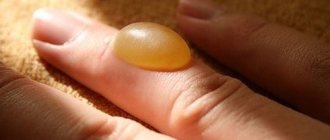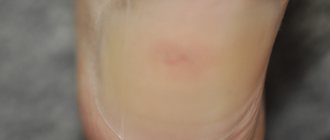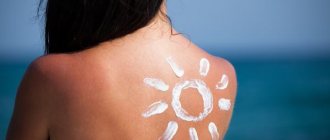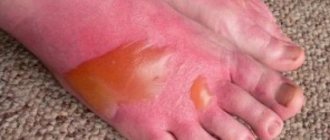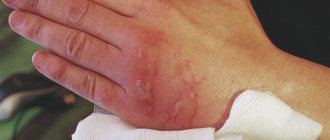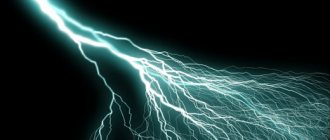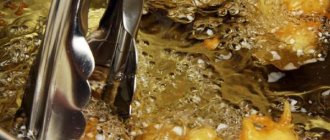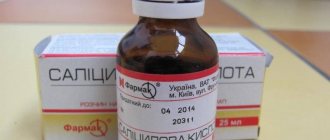An alcohol solution of iodine disinfects wounds well, but in inexperienced hands it can cause serious harm, leaving large burns on the body. Therefore, in medical practice, the use of iodine is practically reduced to zero. But, despite this, there are still many admirers of the alcohol solution of iodine, so cases of iodine burns are not so rare.
- 2 Pharmaceuticals
- 3 Folk remedies
3.1 Gallery of folk methods
Causes
Iodine is a highly concentrated alcohol solution, which, if used incorrectly, can cause a burn to the surface being treated.
For medical purposes, it is used as an antiseptic to treat affected skin.
Iodine burn can occur when:
11
- Large quantities and area of application.
- Processing that continues beyond the permitted period.
- Penetration of the substance into the wound itself.
- Performing enemas with a solution of the drug.
- Contact with mucous membranes of the mouth and genitals.
- Using the drug in food.
- Using an expired product or when the medicine was stored incorrectly.
- Individual intolerance.
- Predisposition to allergic reactions.
Can iodine burn skin?
The medical antiseptic contains 46% ethanol and 5% active iodine.
Important!
In correlation, the substances acquire the ability to destroy organic protein compounds - collagen, elastin and keratin, which are part of the epidermis.
The destruction of these proteins leads to painful deformation of the skin structures.
A skin burn caused by iodine can be caused by incorrect use of an antiseptic:
- independent increase in dosage;
- application directly to the wound rather than treating its edges.
When protein compounds are destroyed due to excessive use of iodine, burns occur.
Burn damage to the skin of the arms, legs and other parts of the body from iodine mesh develops as a result of long-term use of the drug for inflammatory lesions of peripheral nerves and muscle tissue (neuralgia, myalgia).
A burn with iodine in the mouth and throat is keratinization of the epithelium, otherwise known as the mucous membrane. The pathological condition is the result of a response to the aggressive action of an alcohol solution.
Features and degrees of burn
The iodine burn resembles a brown spot. The size of the damage depends on the amount of product used and the area of application. In fair-skinned patients the burn is light brown, in dark-skinned patients the burn is dark. Over time, the burned cells begin to peel off.
Based on the severity of damage, chemical burns are divided into 4 degrees:
- Light redness of the tissues in the 1st degree of damage does not cause significant discomfort; it may burn the skin a little due to its tightness.
- Grade 2 is characterized by the appearance of blisters with clear liquid that cause severe pain. The blisters cannot be burst, otherwise a scar or a source of secondary infection may form at this site. Sometimes in this condition the temperature may rise.
- Grades 3 and 4 are extremely rare and require urgent hospitalization. This usually includes iodine burns on the face , eyes, and mucous membranes in the throat.
Terms of use
- Cauterization of acne is done on cleansed skin. It is better to wash your face with gel or foam. Soap is not suitable here: iodine already dries the skin, and with soap it does it doubly so.
- A cotton swab is moistened with iodine solution. Lubricate the pimple without pressing hard. You should not hold the stick on the inflammation for too long - it can cause a burn. Maximum – 15 seconds.
IMPORTANT . Blackheads are lubricated if they are pinpointed. Large areas of damage require different treatment. Iodine is no help here.
You need to lubricate until the pus comes out or until the inflammation goes away. This usually happens within about a week, and for some people the results appear within a couple of days.
CAREFULLY ! You should not use the product for more than two weeks: it may cause dryness, irritation or burns.
The anti-acne treatment is effective at night. A feeling of slight tightness on the skin is normal ; a nourishing cream is not needed - it will reduce the effect to zero. You can treat your face with an antibacterial cream containing salicylic acid.
This spot cauterization is suitable for combating different types of skin problems:
- subcutaneous acne (especially effective for newly emerging acne);
- ulcers, whiteheads (pulls the contents out).
Cauterization does not bring results for blackheads . And here is a mixture of iodine solution (4 drops) and salt (tbsp). You need to add hot water (half a glass) and stir. Wipe areas covered with blackheads with a warm solution in the morning and before bed. You can make a compress.
Iodine is an antiseptic, so it can be used to treat acne wounds. The solution accelerates tissue regeneration and promotes healing without scars.
Symptoms
With mild damage, signs of a burn may not appear immediately.
To understand that iodine has caused injury, help:
- Deformation of the mucous layer if the drug was applied near these structures.
- A burning sensation is characteristic of tight skin.
- Tearfulness, eye hyperemia, severe pain are observed when the organ of vision is damaged.
- Peeling.
- Brown spot.
- Itching.
- Hyperemia.
- Swelling.
- Dyspeptic disorders when entering the esophagus.
- Cough is typical when the respiratory system is damaged.
- Rash and shortness of breath occur when you have an allergic reaction to the drug.
conclusions
- If iodine gets on the skin, the burn is not dangerous and can be quickly removed by yourself.
- But getting the medicine on the cornea or skin around the eyes is much more serious and can lead to serious consequences.
- Therefore, iodine must be stored in a tightly closed bottle and out of the reach of children, and used while observing safety precautions.
- If the solution gets on the surface of the eye, you should immediately rinse it with running water and immediately go to the emergency room or call an ambulance.
What to do
Having received an iodine burn, what to do before the doctor arrives interests many patients. The first thing to know is that iodine injury is a chemical injury.
Next you need to act according to plan:
- The wound should be kept under running water for about 15 minutes.
- If there are no blisters or serious damage to the skin, then sprinkle the affected area with tooth powder. If you don’t have powder, you can dilute toothpaste with water and apply the product as an ointment. As a last resort, use a soap solution.
- Sweet water can also reduce the effects of the drug. To prepare a concentrated solution, you need to take 25 g of granulated sugar per 100 ml of liquid.
- Severe injuries cannot be treated at home. Before the doctor arrives, you can offer the patient pain medication.
For minor burns, the condition returns to normal within 2-3 days. If during this time there is no improvement or the patient has become worse or the temperature has risen, then consultation with a surgeon is required. Cloudiness of the fluid in the blisters is also an alarming sign and indicates infection.
If the mucous layers, eyes, or oral cavity are damaged, then nothing can be done, as this could lead to a deterioration in the patient’s well-being.
How to remove iodine burns at home?
Therapy for a burned oropharyngeal cavity and eyes is prescribed by a surgeon or a combustiologist - a burn surgeon. Also take a small child with burn injuries to a specialist.
To provide emergency assistance you must:
- Quickly ensure contact of the affected area of skin with running water at room temperature for a quarter of an hour. The same time is needed to rinse the burned oropharynx if the antiseptic gets on the tongue, and to wash the mucous membrane of the organs of vision.
- Apply an oral hygiene product to the injured skin - tooth powder, paste or a concentrated solution of soapy water. This will help neutralize the iodine.
To relieve severe pain, take a tablet non-steroidal anti-inflammatory drug (Artrocam, Next, Ibuprofen).
In case of chemical damage to the eyes, emergency medical care is required.
Drug treatment
If a patient is interested in it with medications a burn from iodine
Typically used:
- Antiseptics.
- Painkiller.
- Regenerating creams and ointments.
- Decongestants.
- Antihistamines for allergies.
In case of a burn, treat with Panthenol. You can apply Spasatel, Bepanten, Dermazin or Olazol to the affected area.
If the wound becomes infected, such treatment is contraindicated. It is necessary to bandage the affected area with a solution of aqueous Chlorhexidine or Furcilin. In this case, local antibiotic drugs Baneocin and Levomekol are also indicated.
For eye burns, drops Floxal, Tsiprolet, Gentamicin are prescribed. But they can be instilled after medical treatment and complete removal of the aggressive component by rinsing with water.
Folk remedies
At home, you can treat with folk recipes only for grades 1 and 2 of the severity of the lesion. The most popular means include:
- Potato. The vegetable is peeled, washed and grated. The pulp is applied as a lotion to the affected area.
- Tea. The bandage is moistened in strained fresh tea leaves and applied cold to the wound.
- Decoction of oak bark. 1 tbsp. A spoonful of dry substrate is poured with 2 cups of boiling water and boiled for 5-10 minutes. Next, the broth is allowed to brew and filtered. The wound needs to be treated 2 times a day.
If there are burst blisters, home treatment should not be used. It is necessary to contact a surgeon or traumatologist.
What not to do
If you receive a burn, the following is contraindicated:
- Apply ice.
- Apply oils.
- Warm up the burn site.
- Pop blisters.
- Apply alcohol solutions.
- Treat the outbreak with potassium permanganate.
If your eyes are damaged, no treatment should be used. In this case, only doctors can neutralize iodine. If your throat or tonsils are damaged, you can rinse your mouth with cool water.
About the features of first aid for a chemical burn in detail in this video
First aid
Before going to the hospital, or while waiting for an ambulance , the victim must be given first aid to alleviate his condition.
For an adult
If iodine gets into your eye, you need to rinse it urgently . To do this, pour cool water into a deep basin, lower your face into it and blink frequently.
Keep in mind! The washing process should last at least 15 minutes, of course, with breaks to inhale oxygen.
If there was a contact lens in the eye at the time of the injury, it should be thrown away.
The skin around the eyes must be treated with any folk remedy.:
- sugar solution;
- decoction of chamomile with sage;
- sea buckthorn oil.
Then you need to rummage through your home medicine cabinet and find any ophthalmic drops or ointment with an antiseptic effect.
Of course, drops are intended for instillation into the conjunctival sac, gel or ointment - for treating the eyelids and skin around the eyes.
After this, a sterile bandage is applied to the eye, and the victim should be immediately taken to the hospital.
It is worth noting! This algorithm cannot be limited, even if the discomfort has disappeared. Medical assistance is required in any case.
Rinsing only protects against iodine penetration into the deeper structures of the eye, but this does not make the burn disappear.
To kid
It is more difficult to provide first aid to a child: he is most likely scared, cannot cope with panic, cries and is afraid of his parents’ actions.
Parents will have to drown out their tenderness and affection and act immediately : if the baby resists, they need to use force.
The procedure is not much different.
The most important thing is to rinse your eyes well with running water. This should be done for 15 to 30 minutes, depending on the degree of the burn, as well as how much time has passed since the injury.
Stay up to date! If the child is old enough to lower his head into the pelvis and blink rapidly, this method is suitable.
Kids will have to artificially keep their eyes open, exposing them to a gentle pressure of running water.
Eye rinsing should continue until the ambulance arrives: the use of any medications and folk remedies is strictly prohibited .
Consequences
Typically, an iodine solution does not cause serious damage. Redness, allergic manifestations, and a dark spot may persist at the burn site. Recovery is more difficult in patients with damage to the mucous membranes and eyes.
The greatest danger comes from oral consumption of the pure product. In this case, the lethal dose is about 3 g of the substance.
Even if a smaller amount of medicine is drunk, patients experience serious disturbances in the functioning of the kidneys, digestive, respiratory, and cardiovascular systems.
Iodine burns occur quite often in everyday life. Usually it does not cause significant harm to health. To prevent negative consequences when using the product, you should carefully follow the recommendations specified in the annotation.
